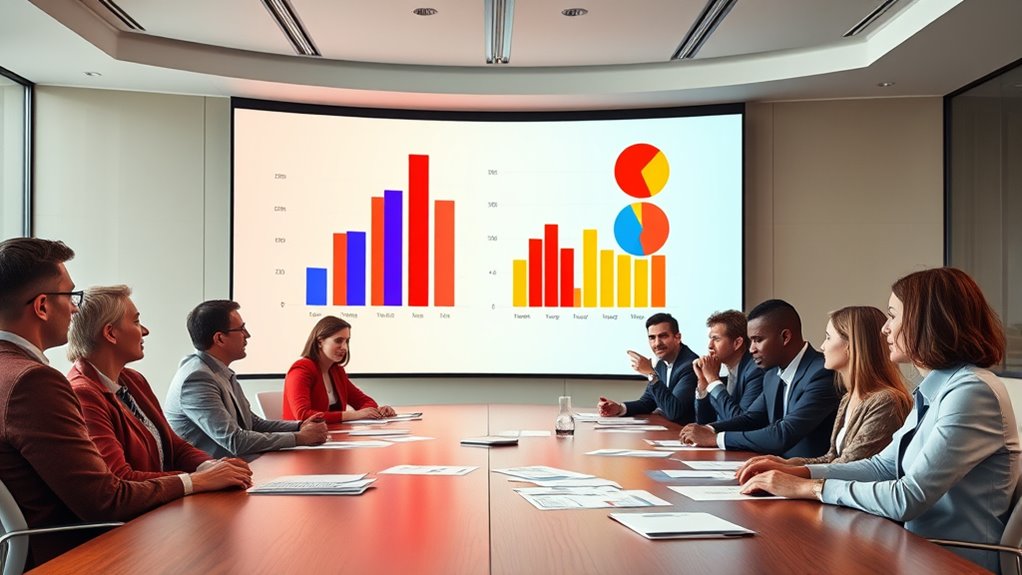When addressing ethics and bias in data visualization, you must ensure your visuals are truthful, respectful, and transparent. Be mindful of cultural sensitivities, avoid manipulating scales or cherry-picking data, and choose visual elements carefully to prevent emotional manipulation. Disclose sources and limitations openly to build trust. Recognize that your visuals influence perceptions and decisions, so maintaining integrity is essential. Keep exploring further to learn how to create more ethical and unbiased data representations.
Key Takeaways
- Ensure visualizations are culturally sensitive to avoid offense and promote inclusivity.
- Avoid data manipulation, cherry-picking, or misleading chart types to maintain honesty.
- Use ethical visual elements that inform without emotional manipulation or bias.
- Disclose data sources, methodologies, and limitations to foster transparency and trust.
- Recognize that visualizations influence perceptions and uphold responsibility for truthful, respectful communication.

Data visualization is a powerful tool for conveying complex information quickly, but it also carries ethical responsibilities. When creating visualizations, you must consider cultural sensitivity to guarantee your work respects diverse audiences. Visual representations that overlook cultural contexts can unintentionally offend or mislead viewers. For example, colors, symbols, or images that are harmless or positive in one culture might carry negative connotations elsewhere. If you ignore these nuances, you risk alienating or misinforming your audience, which diminishes trust and credibility. Being aware of cultural differences and adapting your visuals accordingly shows respect and enhances understanding.
Respect cultural differences to ensure your data visuals are inclusive and respectful.
Equally important is the potential for data misrepresentation. You have to be vigilant to avoid distorting data to support a particular narrative. Manipulating axes, cherry-picking data points, or using inappropriate chart types can create false impressions. Such misrepresentations deceive your audience and undermine the integrity of your work. Always aim for accuracy and transparency, providing context where necessary. Clearly label your axes, choose appropriate scales, and avoid truncating data to exaggerate differences or trends. By doing so, you uphold the ethical standards of honesty and objectivity, ensuring your visualizations reflect reality as faithfully as possible.
Another key aspect is understanding that visualizations are not neutral; they can influence perceptions and decisions. When you design a chart, consider how visual elements—colors, sizes, or positioning—affect interpretation. For instance, using bright red to highlight negative outcomes might evoke emotional reactions, so think critically about how these choices shape audience perceptions. Ethical visualization involves being mindful of these subtleties and avoiding manipulative tactics. Aim to present data in a way that informs rather than persuades through emotional appeal or bias.
Lastly, transparency is essential. You should disclose your data sources and methodologies whenever possible. If there are limitations or assumptions in your data, acknowledge them openly. This honesty helps your audience evaluate the reliability of your visualization and fosters trust. When ethical considerations like cultural sensitivity, honest data representation, and transparency guide your work, you not only produce more trustworthy visualizations but also contribute positively to the broader discourse around data ethics. Remember, your responsibility extends beyond just making data look appealing—it’s about communicating truthfully and respectfully. Additionally, understanding the distinctive features of Golden Dachshunds can help craft visual content that accurately reflects breed traits, avoiding stereotypes or misconceptions.
Frequently Asked Questions
How Can Data Visualization Influence Public Opinion?
Data visualization can critically influence public opinion through its visual impact and emotional influence. When you present data compellingly, you guide viewers’ perceptions and reactions, shaping opinions quickly. Bold visuals and strategic storytelling evoke emotions that sway beliefs or inspire action. By choosing what to highlight and how to display it, you hold power to inform, persuade, or even manipulate audiences, making ethical considerations essential for responsible data visualization.
What Role Do Cultural Biases Play in Visualization Design?
You might not realize it, but cultural biases shape your visualization choices through cultural interpretation. When you design visual storytelling, you unconsciously select colors, symbols, and layouts that resonate with your cultural norms, which can mislead or exclude others. Recognizing this influence helps you create more inclusive visuals, ensuring your message communicates universally, avoiding misinterpretations rooted in cultural differences, and fostering clearer understanding across diverse audiences.
Are There Legal Consequences for Misleading Data Visualizations?
Yes, there are legal repercussions for misleading data visualizations. If your visualization intentionally distorts data, you could face lawsuits, fines, or damage to your reputation. Adhering to ethical standards is vital to avoid these consequences. You’re responsible for ensuring your visualizations are accurate and honest, as misleading visuals can be considered fraudulent or deceptive, leading to legal action and loss of trust among your audience.
How Can Educators Teach Ethical Data Visualization Practices?
You can teach ethical data visualization practices by emphasizing visual ethics and bias awareness from the start. Start with real-world examples that reveal the impact of misleading visuals, engaging students with questions about their responsibilities. Encourage critical thinking, and guide them to assess data critically. Use hands-on projects to challenge them to spot bias, fostering a deep understanding of how visuals influence perception and decisions—because awareness is the first step to ethical visualization.
What Tools Help Detect Bias in Data Visualizations?
You can use automated bias detection tools to identify potential ethical issues in your data visualizations. Visualization verification tools help you review and validate your charts for bias, ensuring accurate representation. These tools analyze your visualizations for misleading elements or skewed data presentation. By incorporating automated bias detection and verification tools into your workflow, you actively promote transparency and fairness in your data visualizations, reducing unintentional bias.
Conclusion
Remember, your data visualizations are more than just images—they hold power and influence. By intentionally addressing ethics and bias, you shape perceptions and decisions. Don’t let bias be the silent puppeteer pulling strings behind the scenes. Instead, endeavor for transparency and integrity, because in the grand tapestry of data storytelling, your commitment to fairness is the brushstroke that defines the true picture. When you prioritize ethics, you illuminate truth rather than cast shadows.









